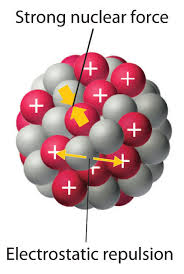Overview
The fundamental types of force are gravity, electromagnetic, weak nuclear, and strong nuclear. All other forces, such as friction and centrifugal force, are special cases of those forces. Physicists understand forces as resulting from the interaction of systems and fields.
Gravity
Gravitational force is the attraction between physical bodies. It is a weak force that operates over long distances; keeping things on the surface of the earth from flying off the earth; ensuring that planets stay in their orbits unless something interrupts them; and holding planets, stars, and galaxies together. For most purposes, Newtonian equations of gravity and classical mechanics are sufficient, even though Einstein’s theory of relativity is a more accurate explanation.
Electromagnetism
The electromagnetic force between charged particles is much stronger than gravity. Objects either attract or repel depending on whether they have opposite charge or the same charge. Since elements consist of positively charged protons and negatively charged electrons, chemical reactions are dependent upon electromagnetic forces. The entire electromagnetic spectrum goes from radio waves at the lowest frequencies through microwaves, infrared, visible light, ultraviolet, to gamma rays.
Nuclear Forces
The weak nuclear force mediates radioactive decay. The heat energy generated from natural radioactive elements found in the crust of the earth raises the temperature, contributing to volcanoes, earthquakes, and other seismic phenomena. The weak nuclear force is combined with electromagnetic energy in modern quantum theory to describe conditions at very high energies, such as might have occurred at the beginnings of the universe. The combination of those two forces is known as the electroweak theory. The strong nuclear force is the strongest of the nuclear forces, but it operates at a very short range, over the distance of an atomic nucleus. It binds particles together. Positively charged protons would repel one another by the laws of electromagnetics, if it weren’t for the strong nuclear force.
Unified Theory
Although physicists have developed theories that describe and predict interactions between matter and types of force, the theories are not necessarily unified. For example, gravitational forces do not appear to operate the same way that electromagnetic forces do. Many subatomic particles such as bosons, quarks, and muons have been observed in high-energy particle accelerators. However, gravitons have not been observed directly.
Interested in science tutoring services? Learn more about how we are assisting thousands of students each academic year.
<span class=”tutorOrange”>SchoolTutoring Academy</span>is the premier educational services company for K-12 and college students. We offer tutoring programs for students in K-12, AP classes, and college. To learn more about how we help parents and students in Middlesboro, KY: visit Tutoring in Middlesboro, KY




